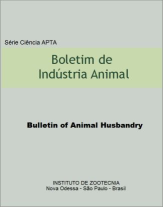Efficacy of the odor of essential oil of Corymbia Citriodora on the tick Rhipicephalus Microplus
Keywords:
acaricide, essencial oil, eucalyptus, odor, tickAbstract
Rhipicephalus microplus can cause diseases to the host and large economic losses to livestock breeders. The ticks€™ first pair of legs contains Haller€™s organs, which have olfactory receptors capable of detecting the odors of volatile substances. The aim of this work was to evaluate the efficiency of the odor of Eucalyptus essential oil on larvae and teleogines of R. microplus exposed for 72 hours. The study was carried out in the Parasitology Laboratory of the CPDGRA, Institute of Zootechnics, Nova Odessa, São Paulo state. C. citriodora essential oil, obtained from the company Dierberger Óleos Essencias, was diluted at concentrations of 10, 20, 40, 60, 80 and 100 mg.g-1. A sample of each concentration (1 ml) was poured onto a filter paper disc (4.5 cm diameter) and after total evaporation of the solvent it was transferred to the experimental unit, composed of 2 Falcon tubes with 50 ml capacity, which were coupled to each other forming two compartments: A (upper tube receiving larvae or teleogines); and B (lower tube receiving the filter disc impregnated with the test solution). Tube A was cut at the bottom (1 cm from the base) and an inlet with tube B with filter paper allowed the odor from tube B to pass to tube A. The cover of tube A was perforated and closed with another filter paper to allow the odor to pass through. After the exposure time (72 hours), live and dead larvae were counted (experiment with larvae); in the experiment with teleogines, they were transferred from the experimental units to a Petri dish and incubated in a BOD with controlled temperature (27 °C) and humidity (80%) to perform egg laying (28 days). The eggs were weighed and placed in glass vials (10 ml) sealed with cotton, and after hatching, the percentage of larvae born was evaluated. The larvae and teleogines were tested with 5 replicates, using approximately 100 larvae (± 21 days of life) and 5 teleogines for each replicate. Up to 72 h, the experimental units were at room temperature, about 28 °C, inside a tray of water and exposed to a humidifier to ensure moisture. The control treatment was put in a different place. For larvae, the numbers of dead and live larvae were analyzed. For teleogines, the efficiency of the product (EP) was calculated using the formula: EP = (CRI (control reproductive index) - TRI (treated reproductive index) / CRI) x 100. The Tukey test was used to compare the differences between means at 5% significance. Statistical calculations were performed by Minitab release 13. The analysis of variance showed significant differences (P<0.001). In the larval test, all concentrations killed significantly more larvae than in the control group (P<0.05), and there were no differences among the different concentrations (P>0.05). The mean mortality of all the concentrations was 26.7%, varying from 20.66 ± 2.06% (10 mg.g-1) to 32.38 ± 10.87% (40 mg.g-1). For teleogines, the best efficacy results were 98.2 ± 10.23 %, 95 ± 2.07 % and 87 ± 9.72 % for the concentrations 100, 10 and 80 mg.g-1 (P<0.05) respectively, and all treatments presented efficacy greater than 50% when compared to the control group (P<0.05). We can conclude that the odor of C. citriodora essential oil has acaricidal action on the larval and teleogine stages of R. microplus.
Downloads
Downloads
Published
Issue
Section
License
Os autores não serão remunerados pela publicação de trabalhos, pois devem abrir mão de seus direitos autorais em favor deste periódico. Por outro lado, os autores ficam autorizados a publicar seus artigos, simultaneamente, em repositórios da instituição de sua origem, desde que citada a fonte da publicação original seja Boletim de Indústria Animal. A revista se reserva o direito de efetuar, nos originais, alterações de ordem normativa, ortográfica e gramatical, com vistas a manter o padrão culto da língua e a credibilidade do veículo. Respeitará, no entanto, o estilo de escrever dos autores. Alterações, correções ou sugestões de ordem conceitual serão encaminhadas aos autores, quando necessário. Nesses casos, os artigos, depois de adequados, deverão ser submetidos a nova apreciação. As opiniões emitidas pelos autores dos artigos são de sua exclusiva responsabilidade. Todo o conteúdo deste periódico, exceto onde está identificado, está licenciado sob a Licença Creative Commons Attribution (CC-BY-NC). A condição BY implica que os licenciados podem copiar, distribuir, exibir e executar a obra e fazer trabalhos derivados com base em que só se dão o autor ou licenciante os créditos na forma especificada por estes. A cláusula NC significa que os licenciados podem copiar, distribuir, exibir e executar a obra e fazer trabalhos derivados com base apenas para fins não comerciais.













